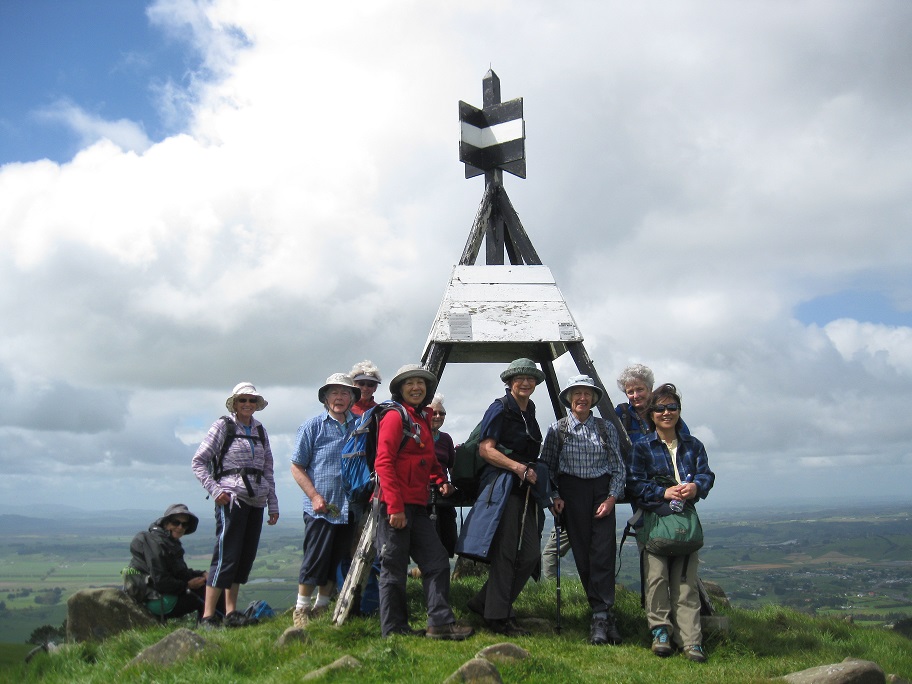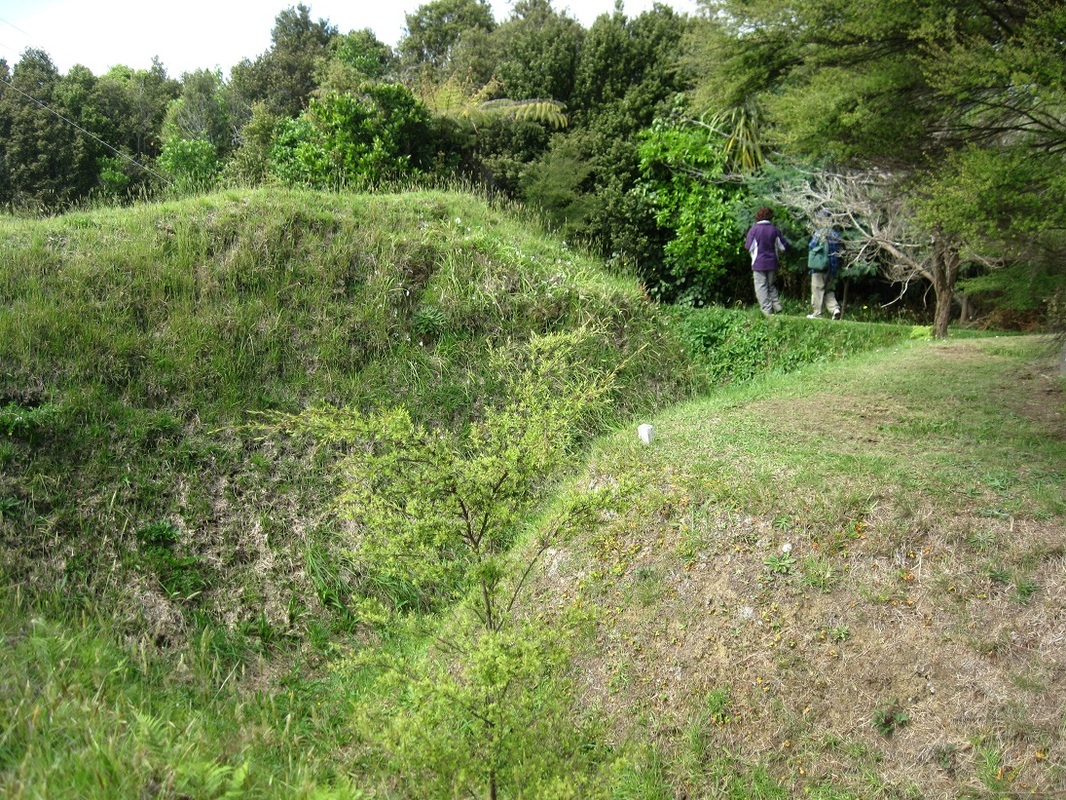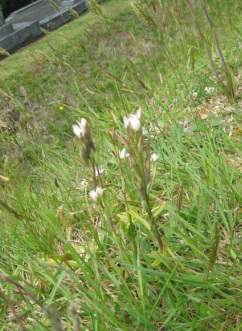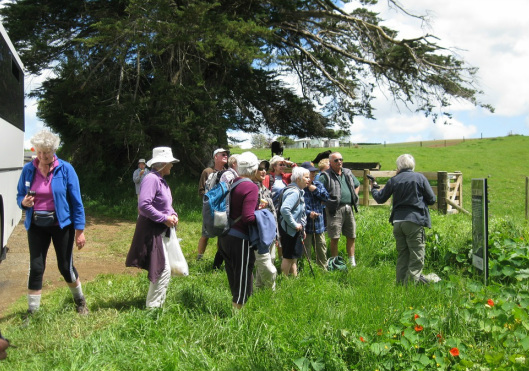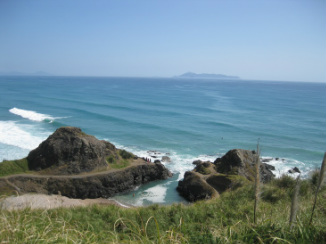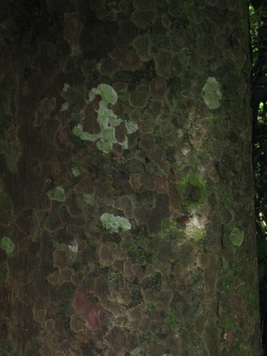Trip Reports, October - November 2013
Mataia Homestead
13 October
There were a good number of members interested in this, a new walk for the Club. We were met at the main
gate by our hosts for the day, Sean and Jill and we drove around to the start of the walk, where we had a short talk about the history of this property. From there, we went past the clay pits where excavations had taken place to extract silica for use in glass making and fibre board manufacture.
Following an easy track we went downhill a good way before a quick stop for morning tea in thick kanuka forest right beside the thriving mangrove. There we heard the two- note calls of a pair of fernbirds, rarely seen and rarely heard. Other birds also added to the melody from time to time, fantails and warblers being prominent among them.
We walked close to the mangrove areas most of the time then, sometimes through bogs, sometimes climbing steeply for short distances, within sight of the Kaipara Harbour all the way. After that, the track went through some very muddy areas, with some steep climbs in places, then followed the coast line for a while, with marvellous views of the Kaipara Harbour. There we could appreciate the extent of the mangroves around the harbour - vast swathes of it could be seen around every inlet covered in Avicenia marina, the commonest mangrove plant of New Zealand.
Arriving at the beach, we had lunch sitting near comfortable “cushions” of Salicornia, a less common inhabitant of
our mangrove swamps, very well adapted to living in tidal conditions. From there we could also see the neighbouring property, Gibbs Farm, with its large outdoor sculptures.
gate by our hosts for the day, Sean and Jill and we drove around to the start of the walk, where we had a short talk about the history of this property. From there, we went past the clay pits where excavations had taken place to extract silica for use in glass making and fibre board manufacture.
Following an easy track we went downhill a good way before a quick stop for morning tea in thick kanuka forest right beside the thriving mangrove. There we heard the two- note calls of a pair of fernbirds, rarely seen and rarely heard. Other birds also added to the melody from time to time, fantails and warblers being prominent among them.
We walked close to the mangrove areas most of the time then, sometimes through bogs, sometimes climbing steeply for short distances, within sight of the Kaipara Harbour all the way. After that, the track went through some very muddy areas, with some steep climbs in places, then followed the coast line for a while, with marvellous views of the Kaipara Harbour. There we could appreciate the extent of the mangroves around the harbour - vast swathes of it could be seen around every inlet covered in Avicenia marina, the commonest mangrove plant of New Zealand.
Arriving at the beach, we had lunch sitting near comfortable “cushions” of Salicornia, a less common inhabitant of
our mangrove swamps, very well adapted to living in tidal conditions. From there we could also see the neighbouring property, Gibbs Farm, with its large outdoor sculptures.
After lunch we had a steep climb (isn’t that always the way?) and an undulating track took us to the best part of the day, a bush walk. Here we saw plenty of young kauri, tanekaha and other natives thriving in a patch of land where pest control was taken seriously!
Finally, going through some paddocks warily watched by steers, we arrived at the Homestead to be treated to a Devonshire tea!
A great day, well organised and thoroughly enjoyed by everyone!
Thank you, Brenda.
Finally, going through some paddocks warily watched by steers, we arrived at the Homestead to be treated to a Devonshire tea!
A great day, well organised and thoroughly enjoyed by everyone!
Thank you, Brenda.
Labour Weekend - Port Waikato
October 26 - 28
Twenty-eight members set off for Port Waikato in high spirits on Saturday morning. Along the way we did two walks, one going up Mt. William and through the Reserve, then Harker Reserve. The first was particularly good: approaching the trig, we passed a thriving kanuka forest, just coming into flower. In the reserve we saw taraire, kahikatea, nikau and rewarewa in profusion. Lunch just outside the reserve had the added attraction of our seeing a shining cuckoo, perched on a young kahikatea, and hearing its distinctive call. Later we saw many forest cabbage trees (Cordyline banksii), some profusely flowering.
|
Sunday’s walk was long and involved a good deal of climbing up and down hills but nevertheless it was enjoyable. We saw attractive young rimu and went through taraire forest to reach a mixed beech forest, passing kahikatea, nikau and rewarewa and clematis in flower, with small birds taking advantage of the nectar. Fantails, grey warblers and tui were abundant and while on an arduous part of the track, the call of a shining cuckoo was heard: what a lift to the spirits! We stopped on the beach for a rest, a snack and some water and before starting the climb on the further side, over a headland. |
Again, kanuka and flowering manuka accompanied us on the way and the tree daisy (Olearia arborescens) was seen in several places. When we reached Port Waikato, we were tired but happy to have had such a marvellous walk: members helped each other over rough ground: fit walkers accompanied those who were less fit and encouraged them; others stayed back at track junctions to guide those who followed; the true spirit of the club was very much in evidence!
That night, we were treated to a slide show on Seabirds by one of our well-travelled members, Nancy. Few of us had been to the Galapagos Islands, so seeing the “blue-footed booby” for the first time, even on film, was quite hilarious! Later we heard a morepork and the first to get up the next morning also saw it!
That night, we were treated to a slide show on Seabirds by one of our well-travelled members, Nancy. Few of us had been to the Galapagos Islands, so seeing the “blue-footed booby” for the first time, even on film, was quite hilarious! Later we heard a morepork and the first to get up the next morning also saw it!
|
Packing our belongings into the bus the next morning, we were entertained by a kereru and its offspring feeding on nikau berries right above us. Starting off, we first visited Alexandra Redoubt: a place of some significance in New Zealand history, it was built around 1870 and originally covered about a third of a hectare. It is one of the best preserved redoubts in the country (the tops of the escarpments are still over 2m. higher than the bottom of the ditches) and was used to safeguard the British forces when they came up the Waikato River. |
It was named after the popular Danish Princess Alexandra, consort of the future King Edward VII.
|
Finally, we went on to Henrys Scenic Reserve near Patumahoe on our way back to Auckland. This is a small but beautiful bit of bush that is a testament to what a community working together can achieve! Many different groups were involved at different stages of the project, but perhaps worth special mention are the local school children, who dragged down all the rocks that surround the bubbling spring.
A wonderful weekend: good weather, good company and good walks, with plenty of natural history to keep us interested. Many individuals can take the credit for this: Derek, Gail, John and Molly for doing the reccies, John for organising the weekend, Joe our driver and many others who helped in so many ways! Thank you, all.
November 10: Change of walk - to Waitakeres Tracks
It was a smaller than usual group, we started our walk at Greenwoods Corner to go up the Grangemore Track to the Kauri Knoll. It was very satisfying to see young miro seedlings scattered about at the knoll, yet again evidence that pest control was having a real effect in this very special part of Auckland.
|
Coming back down the track, we went across to the Scenic Drive then headed for the Incline Track, well named. It’s always good to be walking in the Waitakere Ranges, where the native bush is thriving now, but some of the tracks seem to be muddy all year round!
We then gradually made our way towards the Arataki Visitor Centre, stopping for lunch just after we crossed over a small stream on the Pipeline Track. Going up the newly made Beveridge Track to the Visitor Centre, the views over Manukau Harbour were stunning. |
We saw many, many varieties of mosses, lichens and fungi, we came across lots of hooded orchids and even saw Thelymistra (with unopened flowers), that we had only learnt about during Labour Weekend – a very satisfactory day from the natural history point of view.
Thanks for another enjoyable walk in “our Waitakeres,” John.
Thanks for another enjoyable walk in “our Waitakeres,” John.
Te Arai & Logues Bush
24 November
The 32 members who set off (with two visitors) were really looking forward to doing this easy – moderate walk on such a lovely day and we were not disappointed. We first went along the shore to see where scuba divers went into the sea and climbed up to the rocky outcrop there to get some stunning views of Little Barrier Island.
Retracing our steps a little, we then set off uphill on a well formed track, between lines of flaxes. When we had a short stop for morning tea, we were in the company of several birds, including a green finch, fantails and other small birds. Many “undulations” later, we arrived at a small pond with marsh vegetation all around it. Going along a forest road a short way, we turned into another bush track; it was a welcome relief from the heat and we made good time to arrive back at the beach in time for a leisurely lunch.
Retracing our steps a little, we then set off uphill on a well formed track, between lines of flaxes. When we had a short stop for morning tea, we were in the company of several birds, including a green finch, fantails and other small birds. Many “undulations” later, we arrived at a small pond with marsh vegetation all around it. Going along a forest road a short way, we turned into another bush track; it was a welcome relief from the heat and we made good time to arrive back at the beach in time for a leisurely lunch.
The second walk of the day was in Logues Bush, a marvellous walk for the natural historian or for those who want to learn more about our native trees: name labels placed by trees are very helpful. There were some kauri, lots of rimu, kahikatea, kanuka, nikau etc. There was also an area of taraire, hard to miss due to loads of its dried, leathery leaves lying on the ground. Young seedlings of miro and matai were evident too. Although well past their best, we saw plenty of evidence of green hooded orchids and even a kaikomako with its juvenile leaves shaped like “ducks feet.”
|
Our leader John showed us the differences between the silver fern ponga, the wheki ponga and the black mamaku. We also noted that the enormous matai trees had the classic “hammered bark” on their trunks. All the way through, we were accompanied by birdsong, mostly small birds such as fantails and warblers, but tuis, kereru and the shining cuckoo all made themselves heard from time to time.
Thank you once more John, for a thoroughly enjoyable day. |




